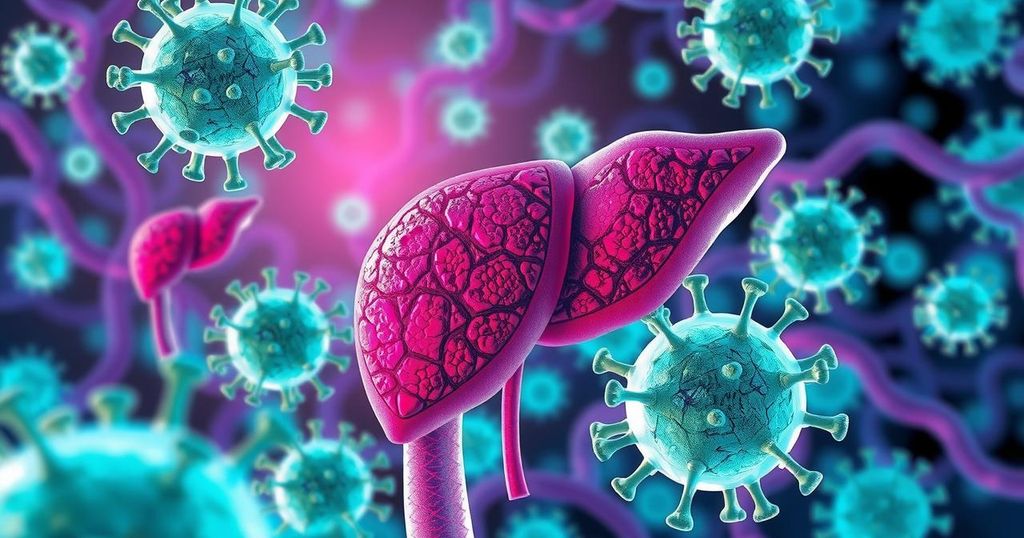Science
CENTER, CLINICAL TRIALS, COMPREHENSIVE, EDUCATION, INSTITUTE FOR GLOBAL HEALTH AND INFECTIOUS DISEASES, JOSEPH ALEX DUNCAN, LEMON, LINEBERGER COMPREHENSIVE CANCER CENTER, MEDICINE, NAT MOORMAN, NATIONAL ACADEMY OF SCIENCES, NORTH AMERICA, PANDEMIC, RESEARCH, SCIENCE, UNC, UNC LINEBERGER, UNC SCHOOL MEDICINE, UNITED STATES, XI, YOU LI
Rajesh Choudhury
0 Comments
Scientists Implicate a Novel Cellular Protein in Hepatitis A Infection
Researchers at UNC School of Medicine have revealed that PDAP1, a little-known protein, plays a crucial role in the replication of the hepatitis A virus within liver cells. Despite an effective vaccine, the U.S. has seen tens of thousands of hepatitis A cases since 2016. By studying how HAV exploits PDAP1, the research team has opened new avenues for understanding cellular processes related to both viral infections and cancer.
A team of researchers at the UNC School of Medicine, led by Dr. Stanley M. Lemon, has spotlighted a protein called PDAP1 in the context of hepatitis A virus (HAV) infection. This virus is particularly notorious for its ability to cause severe liver inflammation and is easily transmitted through close contact and contaminated sources. Despite the availability of a vaccine since the 1990s, the Centers for Disease Control and Prevention (CDC) reported over 45,000 cases and 424 deaths in the U.S. from hepatitis A since 2016.
Dr. Lemon, who has been studying viruses like HAV for decades, noted, “You could say that hepatitis A virus knows the insides of a liver cell much better than we do.” His research endeavors have aimed to unravel the complexities of how hepatitis A interacts with its host, shedding light not just on the virus but also on cellular responses and even aspects of cancer.
Recently, Lemon and his colleagues, including several other renowned scientists, discovered PDAP1’s significant role in hepatitis A infection. This little-known protein was identified using a CRISPR screen that looked at over 19,000 human genes. After ruling out most as irrelevant to the virus’s activity, they found about 40 genes crucial for HAV replication, with PDAP1 being particularly interesting due to its previously unknown function.
Despite only a handful of papers previously noting PDAP1 and its connections to certain cancers, the team realized its potential value in the viral infection context. Notably, one study led by Verónica Delgado-Benito highlighted PDAP1’s role in maintaining immune responses during stress, which piqued the interest of Lemon’s team even further.
Their initial experiments suggested that hepatitis A cleverly leverages the liver’s stress response. When infected, liver cells cut back on many protein productions to conserve energy, focusing on producing special proteins to survive. It appeared that HAV manipulates this process to make proteins necessary for its replication.
To dig deeper, the researchers removed PDAP1 using CRISPR-Cas9 and also studied a mouse model lacking the gene. They found that without PDAP1, liver cells couldn’t support HAV replication, and the mice were entirely resistant to infection, signaling PDAP1’s critical role in the viral life cycle.
Building on these findings, the team discovered more about the integrated stress response. In PDAP1-deficient mice subjected to a toxin, the expected stress response was absent. The cells turned on the right genes but couldn’t produce the needed proteins. This revealed that PDAP1 is vital not just for the virus but also for the overall survival of stressed liver cells.
“We know now that this protein is part of a special program cells use to express a certain subset of proteins under conditions of stress,” commented Lemon. With these insights, he anticipates that researchers interested in protein production and cell survival under stress will further explore PDAP1.
The implications of this research stretch beyond hepatitis A. The integrated stress response is a significant factor in cancer cell proliferation. By investigating the relationship between a virus and its host, scientists can glean insights into cellular mechanisms relevant to infectious diseases and cancer, suggesting a broader significance in future studies.
In summary, the identification of PDAP1 as a crucial player in hepatitis A infection marks an exciting development in our understanding of viral mechanisms. This research not only provides valuable insights into hepatitis A but also sheds light on the integrated stress response, linking it to cancer proliferation. As scientists continue to delve into PDAP1’s role, further implications for both infectious diseases and cancer may emerge, emphasizing the interconnectedness of these biological processes.
Original Source: news.unchealthcare.org




Post Comment